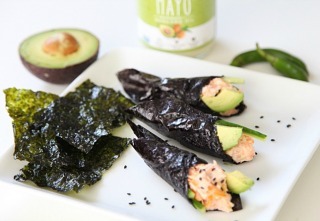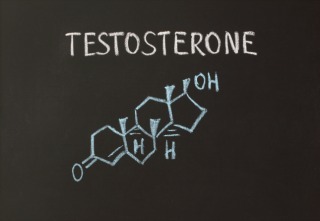Mark Sisson's Blog, page 170
September 10, 2017
Weekend Link Love – Edition 468
 Research of the Week
Research of the WeekYou’re probably drinking plastic.
HIIT works in overweight/obese sedentary adults of both sexes with a good chance of developing type 2 diabetes.
A new study just identified hundreds of new genes linked to intelligence.
Visualization increases performance.
Neural networks can predict your sexual orientation from your facial appearance.
New Primal Blueprint Podcasts
Episode 185: Diana Keuilian: Host Elle Russ chats with Diana Keuilian, best-selling author of the awesome The Recipe Hacker and Recipe Hacker Confidential. If you’re interested in making comfort food without the gluten, soy, grains, sugar, and dairy, this podcast is for you.
Each week, select Mark’s Daily Apple blog posts are prepared as Primal Blueprint Podcasts. Need to catch up on reading, but don’t have the time? Prefer to listen to articles while on the go? Check out the new blog post podcasts below, and subscribe to the Primal Blueprint Podcast here so you never miss an episode.
Interesting Blog Posts
Holland sure is good at growing green stuff.
An incredible story about the deadly (really) search for the newest hominid discovery.
Media, Schmedia
Dr. Vinay Prasad is about to make a whole lot of experts really, really angry.
Everything Else
The lives of Australian crocodile hunters.
The FDA acknowledges giving peanuts to at-risk infants reduces peanut allergy.
Move over, gluten-free water. Free-range tree-grown nuts have arrived.
This is a new low: Faking cancer patients to sell more prescriptions of a new drug.
Things I’m Up to and Interested In
Learning how Primal Health Coaches are changing their own lives with the program.
News that made me happy: After suffering seizures up to 100 times a day, a boy starts taking cannabis oil and has none for 300 days.
Study that answers the question we’ve all been wondering: Oral caffeine is more effective than anal caffeine.
Article I couldn’t put down: The story of silphium, lost Greco-Roman wonder herb.
I’ve been living a lie: Keto is incredibly effective but unfortunately impossible to follow.
I can’t recall ever feeling impressed, envious, revulsed, saddened, and in awe at the same time: Rising surf star dies riding Hurricane Irma’s waves.
Recipe Corner
Barbecue kale chips. I never can get sick of the kale chip thing.
Lamb tagine with potatoes and toasted almonds (no tagine required).
Time Capsule
One year ago (Sep 10 – Sep 16)
How to Accept Your Body After Significant Weight Loss – It can be harder than people imagine.
CRISPR: What Does Gene Editing Mean For the Future of Primal Living? – Is ancestral living headed for obsolescence?
Comment of the Week
“I’m liking the interest in young children and elementary school, but it makes me kind of suspect Mark became a grandfather two to five years ago.”
– Ha! Not that I’m aware of, Ion Freeman. It’s a combination of all the requests we’ve gotten from readers and all the new parents on my staff.
Want to make fat loss easier?
Try the Definitive Guide for Troubleshooting Weight Loss for free here.
The post Weekend Link Love – Edition 468 appeared first on Mark's Daily Apple.



September 9, 2017
Mini Smoked Salmon Hand Rolls
 Sushi hand rolls might sound like an extravagant treat, but this recipe turns hand rolls into a super-easy snack. Kids love these salmon hand rolls after school (maybe omit the hot chiles?) and adults love them pretty much any time of day or night.
Sushi hand rolls might sound like an extravagant treat, but this recipe turns hand rolls into a super-easy snack. Kids love these salmon hand rolls after school (maybe omit the hot chiles?) and adults love them pretty much any time of day or night.
The switch is subbing out raw sashimi grade tuna and using smoked salmon instead. This avoids the issue of mercury from tuna, and makes it easier to pack hand rolls for an afternoon snack at school or work without worrying about spoilage. Plus, the omega-3s from fatty salmon and the monounsaturated omega-9 fatty acids from Primal Kitchen Mayo® mean these hand rolls are both a nutritious and delicious snack.
Let’s get started. Mix up hot chiles, ginger, garlic, sesame oil, rice vinegar and a dollop of Primal Kitchen Mayo. Spoon the spicy salmon onto a square of nori, garnish with thinly sliced cucumber and avocado, fold and eat. It’s so good, and so easy.
Servings: 8 to 10 mini hand rolls
Time in the Kitchen: 10 minutes
Ingredients

8 ounces smoked salmon, shredded into small pieces (230 g)
1 Thai chile pepper or other hot pepper, seeded and finely chopped
1 teaspoon grated ginger (5 ml)
1 small garlic clove, pressed or finely chopped
2 teaspoons toasted sesame oil (10 ml)
2 teaspoons rice vinegar (10 ml)
2 tablespoons Primal Kitchen Mayo (30 ml)
Seaweed Snacks, or Nori cut into 4 squares
Cucumber, thinly sliced
Avocado, cut into thin wedges
Black sesame seeds, for garnish
Instructions

Whisk together chile pepper, ginger, garlic, sesame oil, rice vinegar and mayo.
Mix in the salmon.
Spoon about a tablespoon of salmon onto a small square of dried seaweed. Add a strip of cucumber and avocado. Fold the seaweed around the salmon so it’s in the shape of an ice-cream cone. Garnish with black sesame seeds.

The post Mini Smoked Salmon Hand Rolls appeared first on Mark's Daily Apple.



September 8, 2017
Little Leafy’s Keto Diet Success Story
It’s Friday, everyone! And that means another Primal Blueprint Real Life Story from a Mark’s Daily Apple reader. If you have your own success story and would like to share it with me and the Mark’s Daily Apple community please contact me here. I’ll continue to publish these each Friday as long as they keep coming in. Thank you for reading!
 When our baby daughter, Leafy, suffered a frightening seizure at home we had no idea what was to come.
When our baby daughter, Leafy, suffered a frightening seizure at home we had no idea what was to come.
When more seizures followed a pattern emerged; blue lights to hospital, assessments, nights in hospital wards, medical tests, fear and exhaustion.
Despite the frightening length and regularity these incidents were diagnosed as Febrile Seizures, caused by temperature spikes from ill health.
We carried on as best we could, juggling caring for our 2-year-old son whilst trying to manage Leafy’s reoccurring long-lasting seizures.
As time went on she endured many more seizures. Her worst time was when chicken pox was shared around locally and she caught the infection. Leafy suffered seizure after seizure in 30-degree heat while covered in hundreds of itchy, angry pox marks. It was a real low for us all. We watched her small body struggle so much and were not able to help her.
Finding Keto
 Something was clearly not right, so we started researching. We read late into the nights, on the triggers, the seizure syndromes and the treatments and eventually found the Ketogenic diet.
Something was clearly not right, so we started researching. We read late into the nights, on the triggers, the seizure syndromes and the treatments and eventually found the Ketogenic diet.
The possibility of an evidence based diet that is effective in controlling seizures through food alone seemed golden! We read up on everything we could on following a keto diet, learning the practicalities of how to follow the diet, the potential side effects and how to sensibly mitigate those.
Starting Keto
When Leafy was diagnosed with epilepsy, aged 2, we took the decision to start her on the Ketogenic diet straight away. Food before medication.
 Within days the diet began to have a hugely positive impact. Her shortest seizures, she was having up to 60 per day, stopped and have not returned. Her longer seizures reduced in length and frequency from 3 per week to fortnightly, and continued to reduce.
Within days the diet began to have a hugely positive impact. Her shortest seizures, she was having up to 60 per day, stopped and have not returned. Her longer seizures reduced in length and frequency from 3 per week to fortnightly, and continued to reduce.
Along with dramatic seizure reduction Leafy’s sleep improved, she was brighter, less distressed and wobbly on her feet. We were getting our daughter back again!
Leafy’s Modified Keto Diet
We opted for the Modified KD. It has a lower fat to carbohydrate ratio than Classic KD. With MKD Leafy eats a wide range of low carbohydrate vegetables with moderate protein and liquids and still a good portion of healthy fats.

Medical KD often relies on formula foods and highly refined oils. We opted for good quality nutrient dense whole foods. To optimize her nutrient intake carbohydrates are from low starch vegetables and salads, and her wide range of good fats are from animal sources, nuts and seeds.

Her typical favourite meals include paleo muesli, almond orange cake, cheese and salmon omelette, aubergine pizza and raspberry ripple ice-cream.
My Nutrition Work – Leafie.com
The healthier Leafy became through diet and the more I learned about our body’s need for healthy fats and wholefoods, the more concerned I became with how crazy mainstream foods and diets are.
I have retrained as a Nutrition Advisor and now support other families to rebalance their foods and take their health back into their own hands.
Leafie is named after my happy, vibrant daughter and reflects my passion for sharing what I have learned.
I’m also mad about good fats and taking on the saturated fat myths. I now supply fantastic quality tallow culinary and skincare products—Goodfats.

Marks Daily Apple
I was so inspired to find Mark’s blog. I admire the work he is doing to shatter the prevailing food myths and to bring whole food into the primal low carb movement.


The post Little Leafy’s Keto Diet Success Story appeared first on Mark's Daily Apple.



September 7, 2017
A New Primal Kitchen Restaurant Opens—And a Contest!
 “Nine months ago Kyle and I walked into an empty building with dirt floors and wondered what that moment would feel like when this was all done! Yesterday we had that moment. It was crazy. We walked into our restaurant— done, designed and filled with our amazing staff ready to train! It was like time travel. It’s finally here!”
“Nine months ago Kyle and I walked into an empty building with dirt floors and wondered what that moment would feel like when this was all done! Yesterday we had that moment. It was crazy. We walked into our restaurant— done, designed and filled with our amazing staff ready to train! It was like time travel. It’s finally here!”
These are Devyn Sisson’s words (yup, proud to say my daughter) just yesterday. She and my son, Kyle, will be the second set of franchisees to open the doors of a new Primal Kitchen Restaurant location—tomorrow morning (September 8th) to be exact—in Culver City, CA. The occasion called for some celebrating as you can imagine…and a contest.
When I first took the plunge in designing the Primal Kitchen Restaurant plan, I didn’t know my own kids would decide to take on the challenge for themselves, but I’m so happy they did. I’ve gotten to see them live their vision and literally help build their franchise from the ground up. I’m thrilled to be one of their first customers, and I know they and their team will do a fabulous job of serving Primal fare to the Culver City area. If you’re in or around L.A., be sure to come out this weekend and grab an awesome Primal meal! If you can’t be there in person, you can follow them on their Instagram page.

On July 21st, of course, the South Bend, Indiana franchise opened, and they’ve been bowled over with the response. But that’s no surprise to me…. People want healthy food that tastes great, and the Primal Kitchen Restaurant menu delivers!
I’ll be headed to South Bend for their official Grand Opening that takes place September 29th through October 1st. I’ll be meeting and greeting and signing autographs on Saturday, September 30th, from 11:30-2:30, and I’d love to see you there. If you’re anywhere near South Bend, come join us!

Now, For the Contest…
The Prize:
A full Primal Kitchen® package! That’s right—one of every Primal Kitchen product. All five dressings, Collagen Fuel, Primal Fuel, Mayo, Chipotle Lime Mayo, Avocado Oil, Extra Virgin Avocado Oil, and four boxes of Grass-Fed Collagen Bars. (We’ll ship anywhere you are.)
The Rules:
1. Follow Primal Kitchen Restaurants on Instagram (our central Instagram account, @primalkitchenrestaurants).
2. Comment on today’s Instagram contest post (CLICK HERE!) to tell us in what city YOU’D like to see a Primal Kitchen Restaurant open! Tag friends for bonus entries.
3. You have until midnight tonight, September 7, 2017, 12:00 A.M. PDT.
A winner will be chosen at random and announced at the top of the Instagram contest post at 10 a.m. PDT on Friday, September 8. I’ll also post our lucky winner on Sunday’s Weekend Link Love as well. Good luck!
But, Wait! I’ve Got One More Ongoing Giveaway to Announce….
 I want to see YOU enjoying some awesome Primal fare. To that end, I’m asking for photos of MDA readers eating at one of our Primal Kitchen Restaurant locations. Show us your Grok grub!
I want to see YOU enjoying some awesome Primal fare. To that end, I’m asking for photos of MDA readers eating at one of our Primal Kitchen Restaurant locations. Show us your Grok grub!
Each month I’ll pick one random photo to publish in the Mark’s Daily Apple newsletter. Monthly winners will receive a $50 gift certificate to either Primal Kitchen Restaurants or PrimalBlueprint.com (their choice).
Send photos to mark@marksdailyapple.com, and be sure to mention in the subject line that this is for the “Primal Kitchen Restaurant Photo Contest.”
That’s it! Thanks, everyone. Looking forward to seeing you on Instagram!
And I’d love to hear from you on this comment board as well. What menu items would you like to try most? Do you have a trip planned to one of the locations? (In addition to South Bend and Culver City, we have franchises in the works for Portland, OR, Santa Cruz, CA, Sacramento, CA, Anchorage, AK, and West Valley, Los Angeles. Look for more news soon!)
Thanks for stopping by, everyone. Have a great end to the week.
The post A New Primal Kitchen Restaurant Opens—And a Contest! appeared first on Mark's Daily Apple.



September 6, 2017
9 Factors That Influence Testosterone Levels
 In the last several weeks testosterone has come up on a pretty regular basis. I’ve written about it before, of course, but there’s something about the novel elements (e.g. solar irradiation for certain choice body parts) in recent conversations that’s kept the exchange going. I thought I’d pull back from the peripheral findings a bit today and re-center the discussion.
In the last several weeks testosterone has come up on a pretty regular basis. I’ve written about it before, of course, but there’s something about the novel elements (e.g. solar irradiation for certain choice body parts) in recent conversations that’s kept the exchange going. I thought I’d pull back from the peripheral findings a bit today and re-center the discussion.
As you know, testosterone plays a pivotal role not just for libido levels (although we won’t leave that out), but also for bone density, protein synthesis and muscle building, hair growth, estrogen production, red blood cell production, sperm production—amid other key functions in the body (for men and women by the way).
So, what are some factors that influence testosterone levels for the better and worse for both genders? What are the mechanisms behind these associations? And how do they relate to a healthy Primal life?
Let’s dig in…
Understanding the Testosterone Spectrum
The first question that always comes up is what “normal” or desirable levels should be. As with many of the measurements and markers we seek out, I tend to trust how I feel more than what a single number in time reflects. It’s one thing to suspect you might have a deficiency based on symptoms, but it’s another to talk lab values.
Are you experiencing low energy, low libido, breast development (in men), expanding waistlines, infertility, erectile dysfunction, bone weakness, genital numbness, depression, or reduced muscle mass? (Assuming poor lifestyle habits aren’t behind these…)
My preference at this point would be seek out something like a 24-hour Dutch test. These kinds of tests, which take both urine and saliva samples across the course of a day, can provide a more accurate picture of your hormonal situation, shedding light on hormonal interplays and recognizing that the relationships between testosterone, estrogen, cortisol and certain other hormones matter.
And while I’d like to say you could interpret these results yourself, it’s probably best not to rely solely on that. Consider enlisting the help of a holistic practitioner or Primal Health Coach to guide you through the process of looking at the full picture. This way, you’ll have support for making change that works for you individually, and I don’t have to make troublesome sweeping statements of what a “normal” testosterone level would be for a man or woman of X age. The truth is, it’s almost always more complicated than that. A study out earlier this year attempted to clarify the question for men at least, but as you’ll note—it’s not about hitting an exact number by any stretch.
What Impacts Testosterone?
Back in the day, ancient Greeks were known to knock back a goat testicle or three to boost stamina and athletic performance, while ancient Chinese remedies for impotence continue to prescribe the consumption of various unfortunate animals’ reproductive organs.
But while feasting on the testicles of a goat or the penis of a tiger won’t result in any appreciable gains, certain social, dietary and physiological changes can.
Vitamins and Minerals
While nothing beats a well-rounded Primal eating regime, there’s certain vitamins and minerals that play a distinctive role in T levels. Of course there’s vitamin D, one of the most critical vitamins in the human body (and something most Americans are deficient in). Whether you synthesize it from sun exposure or pop a couple quality, high-potency supplements each day, some research suggests that increased circulating vitamin D in the body correlates to elevated T. Other studies suggest otherwise, but there’s certainly no harm (and a lot of benefits) in getting a bit more D in your life.
Animal testing also suggests that getting adequate levels of vitamin C each day could boost testosterone. A study that gave male rats either 500 or 250 mg/kg ascorbic acid per day found that epididymal sperm concentrations and plasma testosterone were both significantly increased compared to the control group. Another study found that both vitamin C and E were beneficial for improving rabbit semen quality (and by association, testosterone), and that vitamin E appeared even more effective than C.
And then there’s zinc. I’m always a little hesitant to supplement with this trace mineral as it’s easy to go overboard (and needs to be balanced with copper intake), but zinc appears to modulate serum testosterone to a notable degree. A deficiency likely means a drop in T, while supplementing up to normal levels can restore healthy levels. Stick to zinc-rich foods like oysters or grass-fed beef and you should be just fine.
Too Much Green Stuff, Not Enough Meat
This one will come as no great surprise to those of a paleo or Primal inclination: red meat consumption supports healthy testosterone levels. Not only is it an excellent source of zinc, it’s also the most potent source of the amino acid carnitine, which has been linked to improved fertility. The high saturated fat content of the likes of beef and lamb, along with a decent omega 3-6 ratio in pastured versions, doesn’t hurt either.
With those kind of stats, it’s easy to see how a diet lacking in red meat might spell danger for testosterone. Veering away from meat consumption can also result in a calorie deficit for some who aren’t paying attention, which may in turn contribute to reduced T synthesis.
Resistance Training
As you well know, I’m a huge fan of lifting heavy things, one reason being it’s beneficial influence on testosterone levels. As this 2017 study shows, the rise in T activity following an intense bout of resistance exercise is temporary but significant, the effects of which can be felt several hours afterwards.
Generally speaking, the heavier you lift the better, with research suggesting that resting 90 seconds between sets may promote the greatest T mobilization. Another study found that professional rugby players’ testosterone levels responded best to a workout consisting of 5 sets of high pull, bench press, squat and chin-ups at 15 reps each, this time with a 1-minute rest. There remains a lot of variation between studies, so play around with different resistance regimes and see what works best for you.
Sprinting
My other great love when it comes to exercise is sprints, and these too can work wonders for your ailing T levels. The beauty of these short, sharp bursts of energy is their ability to keep cortisol, testosterone’s arch-nemesis, to a minimum. A 2016 study found that 5 bouts of ten-second sprint cycling promoted a significant rise in T compared to control groups, for both men and women. Interestingly, those with higher pre-test T showed a smaller T response to the sprints. Another study indicated that athletes who exhibit good sprint capacity tend to have a higher basal T level.
Overtraining
On the other hand…here’s another reminder to ditch the chronic cardio and not shortchange recovery. A study that followed a professional soccer team over the course of a competitive season found that testosterone levels steadily declined over the course of the season, with corresponding increases in cortisol. Unsurprisingly, the soccer players exhibited a decrease in muscle mass and increase in fat from overtraining and overexertion—not ideal for professional athletes or anyone.
Likewise, professional basketball players, for example, tend to show a steady decrease in total testosterone over the course of a season. Another basketball study found that the higher the average playing time of each player over the course of a season, the lower their T.
When we look at endurance-type exercise and sports, the same holds true. A 2014 study that examined the hormonal impacts of ultra-marathons in men found that testosterone levels were markedly decreased post-race, with those depleted T levels still apparent a day later. Even in considerably shorter endurance runs, it appears that testosterone levels tend to take a bit of a dive.
Continue training if you must, but be sure to prioritize good overall Primal health and ample recovery. You may also consider supplementing with stress-alleviating supplements like certain adaptogens.
Stress
As I’ve already mentioned, when cortisol is elevated, testosterone is diminished—that’s why exercising too frequently or too long is bad news for T. When both are in balance, they complement each other nicely—cortisol promotes muscle wasting and fat gain, while testosterone facilitates muscular hypertrophy and development of lean mass.
But with your hormonal balance out of whack, cortisol can reign supreme. When the body is in a state of chronic stress (physical, emotional, or both) it can be difficult, if not impossible, to achieve those testosterone gains you’ve been striving for. The solution, then, is to stay well away from stress wherever possible.
Add to this mindfulness and meditation for alleviating stress (and therefore elevating T) and getting plenty of sleep. You know the drill…. It doesn’t matter how healthy your habits are—cortisol will remain elevated and T deflated if you’re in a constantly sleep-deprived state.
Healthy Fats
Research shows that low-fat diets are a poor choice for maintaining healthy T levels. Ironically, much of the research demonstrating this principle was conducted in the 1980s, when the low-fat craze was building steam.
Those studies may be old, but they were relatively conclusive in their findings. One published in 1983 showed significant reductions in total T concentrations after switching healthy middle aged men to a low fat diet. Another, published a year later, demonstrated that cutting men’s fat consumption from around 40% to 25% reduced their T levels significantly, but that this drop could be easily reversed simply by upping the fat content once more. A similar 1987 study found that testosterone exhibited much the same response in women after switching to a low-fat diet.
And while it’s more than a little difficult to ferret out the influence of different types of fats on T levels, the limited available evidence certainly supports the argument for healthy fats over typical polyunsaturated forms. This study, for example, found positive correlations between both monounsaturated and saturated fats and T levels, while pro-omega 6 polyunsaturated fat consumption showed a negative correlation. Another study showed that consumption of monounsaturated fat-rich argan and olive oils resulted in significant T increases.
Considering the average Primal diet is rich in both these fats, you should be just fine on this front. If you’re employing keto as a tool in your Primal arsenal, that works great, too. The higher healthy fat intake may offer a boost. Just be sure you’re not chronically low in total caloric intake (those who are trying to lose weight don’t need to worry and can prioritize the weight loss, which can have its own positive impact on testosterone).
Estrogen
The influence that estrogen holds over testosterone ideally deserves its own post, but (for the sake of this already-lengthy piece) I’ll keep it brief. In most scenarios, excess estrogen (i.e. estrogen dominance) means diminished testosterone, a condition that affects both sexes but is far more common in women.
At this point, we can turn our attention to one of the leading culprits of hormonal imbalances and low T in women: oral contraceptives. On average, most oral contraceptives are 600 times more powerful in stimulating the synthesis of sex hormone binding globulin (SHBG) than the natural estradiol produced in our bodies. SHBG binds to sex hormones like testosterone, meaning oral contraceptives can dramatically lower both free T and total T in those women.
Of course, there’s plenty more environmental estrogenic overloads to blame here. Xeno-estrogens, synthetic compounds that mimic estrogen in the body, come from a myriad of sources—most notably from plastics like PVC or the inner coating of cans. While there’s a host of BPA-free plastics now on the market, your best bet is to stay well away from plastics in general.
Other contributors to high estrogen include poor liver function, which otherwise facilitates the excretion of excess estrogen from the body, and weight gain, which increases conversion of testosterone into estrogen.
Competitive Behavior
Testosterone influences aren’t limited to the physical. A 2015 study set out to examine the theory that societal expectations of gender influence testosterone production in both men and women. Researchers conducted tests designed to measure whether the act of wielding power, a decidedly masculine role in most societies, could actually elevate testosterone in both sexes. Turns out it could. They concluded that “cultural pushes for men to wield power and women to avoid doing so may partially explain, in addition to heritable factors, why testosterone levels tend to be higher in men than in women.”
Of course, this isn’t to say that if the exact same societal expectations were placed on both sexes, everyone would have relatively similar levels of testosterone. Biologically speaking, that’s wouldn’t make sense. What it does suggest is that “wielding” a sense of strength in our own lives may influence our testosterone levels. This isn’t an endorsement of narcissistic power games or chauvinistic attitudes. For me, competitive sports (especially individual ones) seem the logical answer, and research supports that choice. Failing that, one could always explore the murky waters of financial risk-taking. As for me, I’ll stick with a game of Ultimate.
But don’t expect these findings to be reflected in contemporary testosterone treatments any time soon. An article published a few months after the power-wielding study raised serious questions about the validity of that study, pointing out discrepancies in gender groups sizes, confounding factors with control conditions, and potential issues with the way in which they measured T. Still, while the findings are by no means cut and dry, the overwhelming consensus is that competitive behaviors very much play a pivotal role in testosterone production.
Nonetheless, there are two sides to competition as everyone knows with the potential for negative as well as positive responses. How we incorporate competition into our lives in healthy ways is an intriguing and personal question, but the takeaway here for me is an invitation to play more than power. What say you?
Thanks for reading, everyone. Thoughts, questions, requests for follow-up information or commentary? Share them below, and take care.
The post 9 Factors That Influence Testosterone Levels appeared first on Mark's Daily Apple.



September 5, 2017
Doing Keto the Right Way: An Hour with Aubrey Marcus
 A couple of weeks ago I sat down with entrepreneur extraordinaire, multi-sport athlete, and consciousness explorer, Aubrey Marcus, for an in-depth and entertaining discussion of everything from hangover cures to keto philosophy.
A couple of weeks ago I sat down with entrepreneur extraordinaire, multi-sport athlete, and consciousness explorer, Aubrey Marcus, for an in-depth and entertaining discussion of everything from hangover cures to keto philosophy.
Marcus has always been one of my favorite people to talk with, and that morning in my backyard was no exception. We covered all things keto—from the mistakes people make in bottoming out their carbs instantaneously to the advantages of stair-stepping the process. I had a chance to share about my upcoming Keto Reset Diet book as well as personal details of my own experience with the keto state. Aubrey offered his latest favorite recipes (inspired by Primal Kitchen® products, no less!), and we talked in full but casual detail how keto dives set us up for genuine, lasting metabolic flexibility and overall health. There’s a lot of science and plenty of laughs here. I hope you enjoy, everybody!
Thanks again to Aubrey for a lively and fun discussion on his podcast. And thanks to everyone for stopping by today. Let me know what you enjoyed about our conversation and any questions it brings up for you. Have a great week.

The post Doing Keto the Right Way: An Hour with Aubrey Marcus appeared first on Mark's Daily Apple.



September 4, 2017
Dear Mark: The PURE Study
 For today’s edition of Dear Mark, I’m addressing just one question. It’s not even a question, really. It’s a study. In the comments to a post from last week, Pedro dropped a line about some very cool research.
For today’s edition of Dear Mark, I’m addressing just one question. It’s not even a question, really. It’s a study. In the comments to a post from last week, Pedro dropped a line about some very cool research.
Hello Mark. No miss: http://www.thelancet.com/journals/lan...
No way would I miss that one, Pedro. Thanks for the note.
This wasn’t quite a question, but it gives good fodder for me to riff on a few things.
First, as I have said for a decade “The less glucose you burn in a lifetime, the healthier you’ll be and the longer you’ll live.” A new study—the PURE study—seems to hint at that. They looked at the dietary intakes of over 135,000 individuals from 18 countries with an average followup of about 7.5 years. They saw what people said they ate then watched what happened to them.
Turns out that people who ate the most carbs had the highest risk of dying.
People who ate more saturated fat than is recommended (under 10% of energy) had longer lives.
People who ate more protein (even animal) also lived longer.
People who ate fruits, vegetables, and legumes lived longer, too, but the benefits plateaued at around 3-4 servings a day after adjusting for variables like education, income, smoking, and exercise.
This is a great study. It appeals to us. It hits pretty much every point we’ve been saying for years.
However…
We have to exercise the same restraint and skepticism with this study that we show when observational studies claim the opposite: that meat is deadly and saturated fat will destroy us all. Many of the same issues apply here.
For example, the unreliability of food frequency questionnaires (FFQs). That’s where you have to fill out a form describing what you ate and how often over the last 12 months. Here’s a sample FFQ (PDF), to get an idea of what they expect people to remember. They aren’t very reliable. People lie. People forget. People tell you what they think you want to hear, downplaying the unhealthy stuff and overstating the healthy stuff. While this last factor is less relevant in studies where the “unhealthy stuff” turns out to be good for us, it’s still a mark against.
Another is the simple fact that it’s an observational study that cannot prove cause and effect.
Of course, some of the study’s critics make mistakes. Katz had one of the most dishonest takes on a major aspect of PURE. The real kicker was his description of non-cardiovascular mortality:
An alleged “surprise” in the PURE data is that higher intake of saturated fat was associated with lower mortality overall. Here, too, however, higher saturated fat intake- which occurred together with higher protein intake- was associated with much reduced risk of non-cardiovascular death. So, does eating more saturated fat protect you from dying when run over by an ox- or does being in a place with access to more saturated fat (i.e., animal food) in the diet mean you eat the ox before he can run you over? And, that, if ever he does run into you- there’s a hospital somewhere reachable?
He plays similar games with other associations between dietary intakes and “non-cardiovascular death.” Katz knows “non-cardiovascular death” doesn’t just mean accidental or violent deaths. It means deaths from diabetes, cancer, and everything else including, yes, accidents and violence. Which do you think causes more “non-cardiovascular” deaths—goring by ox or untreated diabetes? Trampled by yak or colon cancer? Crushed by wildebeest stampede or lung cancer?
But Katz doesn’t mention those other, more common non-cardiovascular deaths. Most people reading his article won’t consider them. It’s not a lie, not technically, but it’s close. He misleads via omission.
That said, he proposes an interesting explanation:
Animal protein and saturated fat consumption were markers of affluence and access to health care. People who ate more of both were healthier because they were wealthier, had access to other healthy (expensive) foods, and could go to the doctor, not because of some intrinsic quality of the nutrients themselves. Those who ate less were poorer, sicker, and more reliant on processed, refined foods.
That could be part of it. I wouldn’t be surprised. The 18 countries were all over the map and included high income (Canada, Sweden, UAE), middle income (South Africa, Turkey, China, Argentina, Poland, Colombia, Iran, Malaysia, Chile, Brazil), and low income (India, Bangladesh, Zimbabwe, Pakistan, Palestinian Territories) nations. The food and health situations vary wildly across those countries.
Yet for the PURE study, researchers corrected for those socioeconomic variables. They corrected for household income and wealth, for economic status of the country of residence. They corrected for just about everything you can imagine, and the results persisted.
One of the biggest criticisms I lob against the typical observation study “proving” the danger of saturated fat/animal protein/egg yolks is the healthy user bias. Animal foods have the reputation as being terrible for your health. “Everyone knows” whole grains are healthier than steak and eggs. Thus, the people who eat more saturated fat/animal protein/egg yolks are also more likely to be sedentary, to smoke, to drink too much, to avoid vegetables, and to do all sorts of other unhealthy things.
The most impressive part of the PURE study is that the benefits of saturated fat/animal protein/fewer carbs survived the healthy user effect. Despite “everyone knowing” that they’re deadly, those who ate more of them still lived longer. That’s powerful.
But don’t get cocky, kid. There’s a lot we don’t know. We can’t hang our hats on the newest, biggest, bestest, bias-confirmingest observational study, just as we can’t hang our heads in despair at the latest observational study to attack our biases.
Go with results. Go with what works for you. Go with what feels right and helps you perform at your best.
What else is there?
Thanks for reading, everyone. Take care. I’d love to hear your take on the study.
The post Dear Mark: The PURE Study appeared first on Mark's Daily Apple.



September 3, 2017
Weekend Link Love – Edition 467
 Research of the Week
Research of the WeekFermentable fiber isn’t just good for gut bacteria. It’s also good for intestinal cells.
More coffee, less dying.
A meta-analysis of nine randomized controlled trials found no evidence for the protective effects of whole grains against cardiovascular disease.
Agriculture gave us smaller jaws and weaker bones.
New Primal Blueprint Podcasts
Episode 184: Mark Sisson and Elle Russ: Hosts Elle Russ and yours truly chat about Elle’s thyroid journey.
Each week, select Mark’s Daily Apple blog posts are prepared as Primal Blueprint Podcasts. Need to catch up on reading, but don’t have the time? Prefer to listen to articles while on the go? Check out the new blog post podcasts below, and subscribe to the Primal Blueprint Podcast here so you never miss an episode.
Two Final (and Favorite) Adaptogens: Rhodiola Rosea and Bacopa Monnieri
Is Keto Bad for the Thyroid?
Interesting Blog Posts
How frequent exposure to natural disasters changed Japanese culture and biology.
How to prepare your free range kid for school.
Media, Schmedia
The long-term health danger of your city flooding: mold exposure.
The games kids at a New York state elementary school playing during recess must be approved by a committee.
Everything Else
Table manners are quite young.
Vegan diets: Still not the best for you and the planet.
Meanwhile, in Houston…
Things I’m Up to and Interested In
Recipe eBook I highly recommend: The one from the Real Food RDs. It’s free when you sign up for their excellent newsletter.
Study I’ll have more to say about: The PURE study.
Article I’m pondering: “How Kids’ Sports Became a $15 Billion Industry.”
Advice anyone can use: How to live a full life.
This is true: If wine could tell a story.
Recipe Corner
Macadamia-crusted Sriracha ranch salmon.
Simple Korean-style cucumbers, for when you don’t have time to ferment.
Time Capsule
One year ago (Sep 3– Sep 9)
How to Deal with Chronic Pain: Psychological Causes and Treatments –Even if it’s “in your head,” it still hurts.
Weekend Link Love – Oldies but goodies.
Comment of the Week
“Before clicking on the link ‘Two Final (and Favorite) Adaptogens: Rhodiola Rosea and Baco…’, I was hoping it was going to say bacon as the second adaptogen.”
– I figured bacon went without saying, Troels Rasmussen.

The post Weekend Link Love – Edition 467 appeared first on Mark's Daily Apple.



September 2, 2017
Grilled Beef Satay
 Satay is often served as an appetizer, but it makes a fantastic main course when served with a rich, creamy satay sauce and crisp raw veggies on the side.
Satay is often served as an appetizer, but it makes a fantastic main course when served with a rich, creamy satay sauce and crisp raw veggies on the side.
In this Primal version of beef satay, sugar is skipped entirely in both the marinade and the satay sauce. It isn’t missed, with coconut milk and macadamia nuts adding plenty of natural sweetness. The meat gets its intense flavor from soaking just 1 hour in a richly seasoned marinade that is sweet, salty and deliciously pungent. The mellow macadamia satay sauce served on the side balances the bold flavors of the meat, although giving the sauce a good, spicy kick is essential—without it, the sauce isn’t nearly as good.
Macadamia satay sauce is amazing with any type of grilled meat and should not be overlooked as a dip for cold, chopped veggies. Plan to serve sliced cucumber, carrots and/or red bell peppers with Primal beef satay for a colorful, flavorful main course or appetizer.
Time in the Kitchen: 45 minutes, plus 1 hour to marinate
Servings: 4
Beef Satay

Ingredients
2 pounds beef top sirloin or flank steak, cut into strips about 2 inches/5 cm long and 1/8 to ¼ inch thick* (900 g)
1 2-inch/5 cm piece fresh lemongrass (white part only), roughly chopped
1 small shallot, roughly chopped
2 garlic cloves
1 2-inch/5 cm piece peeled ginger, sliced
1 tablespoon fish sauce (15 ml)
2 teaspoons tamari or soy sauce (10 ml)
½ cup coconut milk (120 ml)
1 teaspoon ground cumin (5 ml)
2 teaspoons ground coriander (10 ml)
*Meat is easier to slice thinly if it’s really cold. Put the beef in the freezer for 30 to 45 minutes before slicing it.
In a high-powered blender, combine the lemongrass, shallot, garlic, ginger, fish sauce, soy sauce/tamari, coconut milk, cumin, and coriander.
Combine the beef strips and marinade so the meat is completely coated. Refrigerate and marinate 1 hour. Don’t marinate too much longer than this, or the meat can get mushy.
Remove beef from the marinade and shake off excess marinade. Thread 2 to 3 pieces of meat onto each skewer, spacing the meat out on the skewer. If the skewer is too crowded, the edges of the meat won’t get crispy and charred.
On a heated grill over high heat, grill the skewers 3 minutes per side, or until slightly charred on the outside and barely pink in the middle.
Macadamia Satay Sauce

Ingredients
1 cup raw macadamia nuts (or ½ cup raw macadamia butter)
(5 ounces nuts, or 142 g)
2 small garlic cloves, finely chopped
1 teaspoon tamari or soy sauce (5 ml)
¼ teaspoon toasted sesame oil (1.2 ml)
½ teaspoon fish sauce (2.5 ml)
2 tablespoons lime juice (30 ml)
¼ teaspoon cayenne pepper (1.2 ml)
2 tablespoons coconut milk (30 ml)
2 tablespoon water (to thin out the sauce) (30 ml)
In a food processor or blender, blend the macadamia nuts until very smooth.
In a small bowl, whisk together the remaining ingredients: garlic, tamari, sesame oil, fish sauce, lime juice cayenne, coconut milk and water. Pour into the blender with the macadamia nuts. Blend just until combined.
Serve the beef satay skewers with the macadamia sauce and crisp, raw vegetables like cucumbers, carrots and red bell peppers.

The post Grilled Beef Satay appeared first on Mark's Daily Apple.



September 1, 2017
My Journey to Primal
 Growing up I could never have described myself as a healthy person. Thin, yes. Athletic, yes. But as a student I was always missing classes because I would fall ill, and even when I was older I would constantly have the sniffles from allergies and could easily use up a pack of tissues a day. I had a really twisted notion of fitness: as long as I had the energy and endurance for my dancing and my workouts, and as long as I could fit into my old college jeans, then it meant I was on track with my wellness goals.
Growing up I could never have described myself as a healthy person. Thin, yes. Athletic, yes. But as a student I was always missing classes because I would fall ill, and even when I was older I would constantly have the sniffles from allergies and could easily use up a pack of tissues a day. I had a really twisted notion of fitness: as long as I had the energy and endurance for my dancing and my workouts, and as long as I could fit into my old college jeans, then it meant I was on track with my wellness goals.
The event that changed all that was a disturbing result that came back from my Executive Checkup in 2012: a tiny, suspicious growth that eventually was ruled out as benign and quickly removed. It scared the hell out of me. It was then that I swore to avoid consuming or using anything unnatural or toxic to my body, and I set off on a mission to learn about what would help me to achieve true health and never have to go through a scare like that again.
My own Primal Journey was a series of hits and misses over 7 years, which I spent doing self-study and experimenting with my diet and activity to find what would work for me. It was following the Primal Blueprint that finally brought me to a point where I am comfortable and confident with the state of my health. This is why I was driven to be a Primal Health Coach: because I want to help others to cut through the clutter by sharing my own knowledge and experience, and provide guidance based on established research and the latest studies by leading-edge health experts who are part of the ancestral health community.
A Frustrating Start
Like many people, 30 was the age when I started to feel that my metabolism was slowing down. No longer could I eat, drink and party as much as I wanted and still wake up with a flat stomach and unlimited energy. I took to more frequent workouts and calorie restriction so I could maintain my weight.
After finishing my very first full marathon in 2010, my 4-year running career quickly slowed down and sputtered to a stop. I got bored. So I started trying out other things like yoga, Barre and whatever group class was happening at the gym. In 2012 I discovered Bodyrock, a site that provided free, fun and engaging High Intensity Interval Training (HiiT) videos. After just a few weeks of Bodyrocking I noticed how my arms had less jiggle, and an officemate randomly asked me if I was training for something. That, plus the fact that it was so easy to fit the short 12-minute workouts into my early morning routine before work, got me hooked.
After 3 or 4 months of logging my workout scores, seeing my progress (more reps in the same amount of time) and feeling stronger, it was disappointing that my waistline was not budging. Plus, to my dismay, I was gaining weight, I felt bloated almost everyday, and I would get incredibly sleepy after lunch. I couldn’t understand why. I wasn’t on a diet, but I didn’t think it was a problem because I never ate a lot anyway, stayed away from fatty food, never drank sodas, ate burgers only occasionally, and all that. My average calorie intake must have been less than 1400 a day. Someone once joked about my appetite and said that if I ever got into an eating contest with a pigeon, the pigeon would win. And yet stubborn fat remained around my middle, and I hated it.
Clean Eating
One of the guest coaches on Bodyrock said that if Bodyrocking wasn’t working for you, it had to be one of two things: either you weren’t consistently working out, or you weren’t eating right. I was working out almost everyday, so I took a look at their diet tips and discovered Clean Eating, which involves avoiding processed food, trying to get more veggies into every meal and shifting from my usual white rice and bread to complex carbs.
I have to credit Clean Eating for my helping me build my kitchen skills. (Embarrassing as it is to admit, I had always relied on the help to do the cooking all these years, and my husband Dex knew his way around the kitchen much more than I did!) I started preparing more meals at home, and my family found themselves eating all kinds of grains they never knew existed: couscous, bulgur and quinoa. We were buying more fruit and greens and actually consuming them instead of throwing them out because they had gone bad after being ignored in the refrigerator.
I felt great about this change and it was so empowering to know exactly what ingredients were going into every meal. I would often find myself comparing our homemade meals with restaurant dishes and thinking hey, I could do a better job than this!
About four months into Clean Eating I felt healthier, and I wasn’t getting sick as much. Even when there were nasty bugs going around the office I was always left standing, so I knew I was doing something right. And yet the bloating remained, and so did the stubborn fat around my middle. One day I went to the gym and weighed myself, and was so upset to find that I was at my heaviest in the last 13 years! What was going on?
The Paleo Diet
Enter the Paleo diet, based on the premise that human physiology has not changed much since the caveman days, and hence a diet similar to those of early humans is the optimal one. A friend of mine swore by Paleo, and she was looking great, so I found myself reading up a lot on the subject. I geeked out on Charles Poliquin, Mark’s Daily Apple, Robb Wolf and all kinds of health and nutrition sites, and finally gave it a try.
On the Paleo diet, I was eating a lot of meat, healthy fats and veggies. I suffered through a few days of carb withdrawal (which was awful), but the results were very encouraging. My bloating disappeared almost immediately after I cut down on carbs, and my tummy got flatter week after week.
I was so excited with the idea that I could eat as much as I wanted as long as it was on the Paleo- approved list, and so I started cooking up all kinds of Paleo treats: cupcakes, cookies, energy bars and whatnot. So what if they were sweet? They were made with wild honey and pure maple syrup!
And so the weight came back. More than ever before. And once again I was stumped: I was following the diet, so why wasn’t I getting the results I wanted?
Going Primal
I revisited Mark’s Daily Apple and decided to do a reset and listen more to my body and follow its signals. Instead of strictly adhering to a set of diet restrictions, I now focus on making good meal choices. Instead of tiring myself everyday with grueling strength and cardio workouts, I do strength/HiiT only 3 times a week, do active rest days (mostly with short yoga or pilates sessions) for the other 3, and a weekly sprint session but only when I feel like it. For the most part I just try to make sure I move around as much as I can throughout the day and don’t force myself to work out when my muscles are sore. Sleep and stress management round up the picture.
What is Primal health to me? More than following the guidelines of the Primal Blueprint, it’s about making smart, informed choices about food, movement, and lifestyle, and being mindful of your body, your energy levels and moods. So far so good, and so the journey continues….
Issa Aviles, Primal Health Coach


The post My Journey to Primal appeared first on Mark's Daily Apple.



Mark Sisson's Blog
- Mark Sisson's profile
- 199 followers








